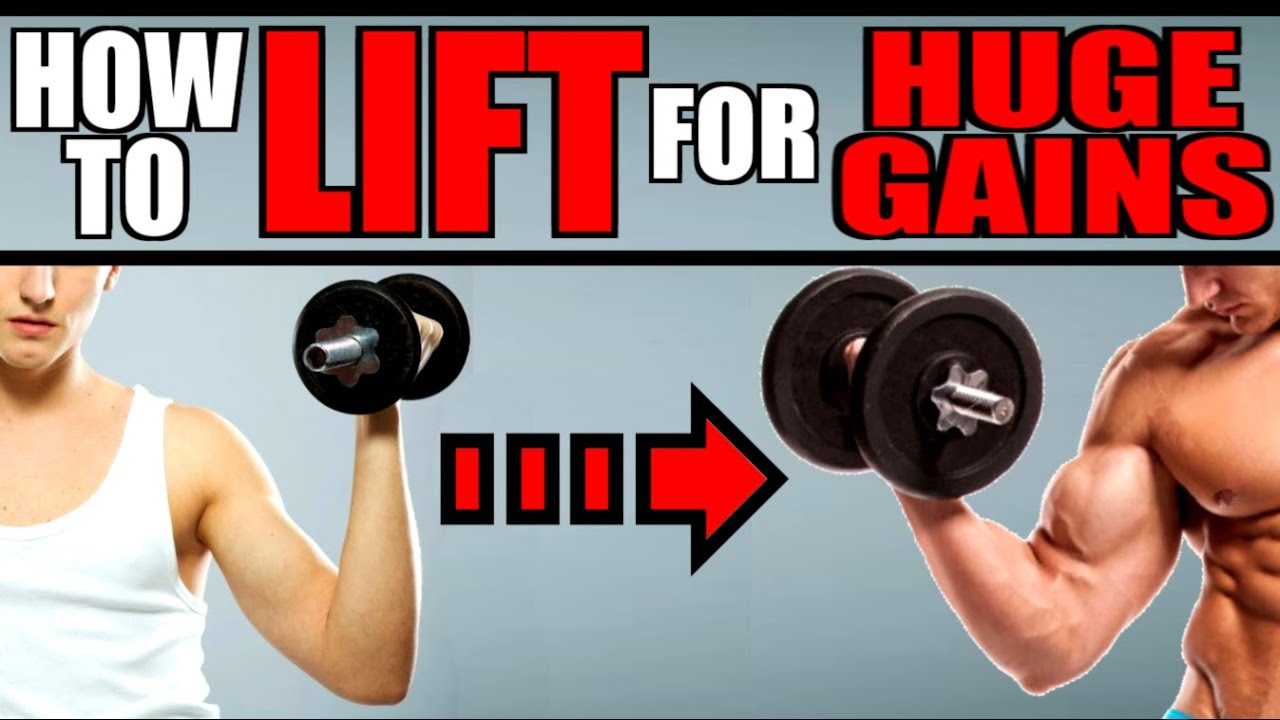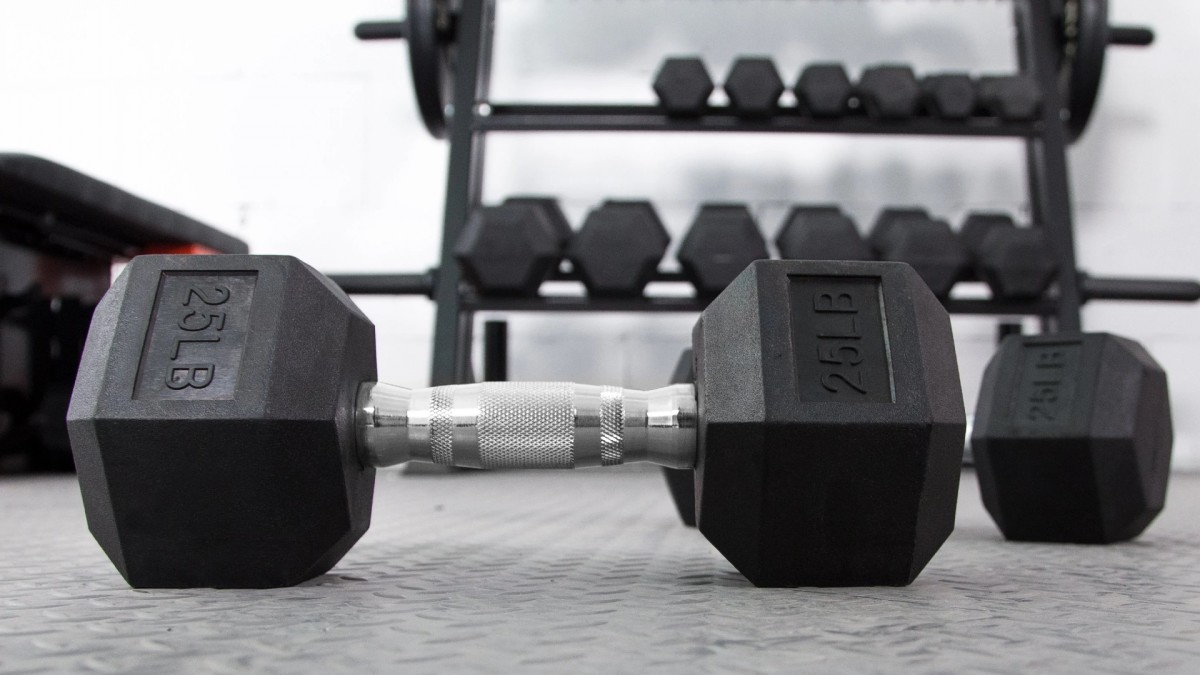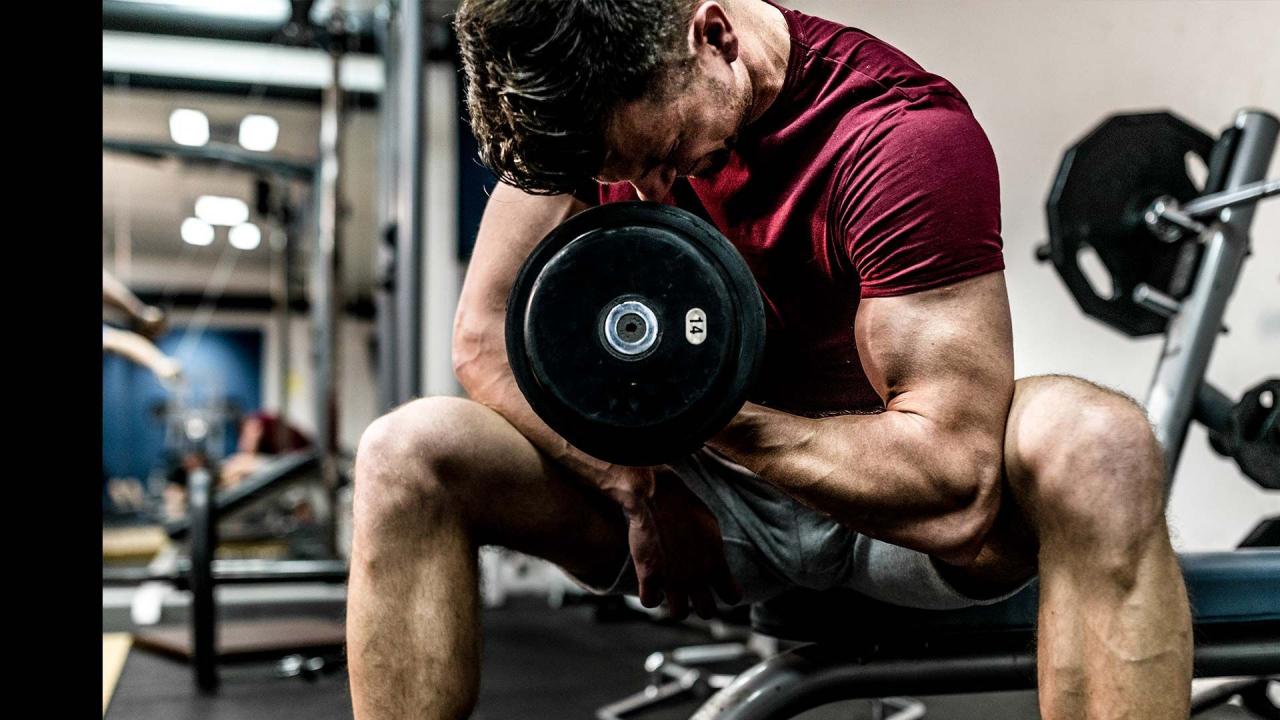Best gym weights for building muscle and strength? Forget the dusty encyclopedias and the grunting weightlifters of yore! We’re diving headfirst into the glorious world of iron, exploring dumbbells, barbells, kettlebells, and even those sneaky resistance bands – each with their own unique personality (and potential to sculpt you into a magnificent specimen). Prepare for a journey filled with gains, glorious muscle growth, and maybe a few hilarious near-misses with gravity.
This isn’t your grandma’s weightlifting guide; we’re ditching the boring bits and focusing on the fun, effective stuff. We’ll decode the mysteries of progressive overload, reveal the secrets to choosing the right weight for your goals (no more guesswork!), and even throw in a killer 12-week workout plan to get those muscles screaming for more. Get ready to unleash your inner weightlifting warrior!
Types of Gym Weights

So you want to build a body that could crush a watermelon with a single bicep curl? Excellent choice! But before you start picturing yourself as the next Arnold Schwarzenegger (or, let’s be honest, a slightly more toned version of yourself), you need to understand the weapons in your arsenal: gym weights. Choosing the right tools is key to avoiding injury and maximizing gains.
So you want to sculpt those biceps like Michelangelo’s David? Choosing the right gym weights is crucial, whether you’re a seasoned lifter or just starting. To really maximize your gains, check out this killer strength building workout plan for women to achieve fitness goals – it’ll tell you exactly how to use those weights! Then, remember, the best weight is the one that challenges you without causing injury – so listen to your body, and get those gains!
Let’s delve into the wonderful world of iron, rubber, and… well, more iron.
Different weights cater to different needs and preferences. Some are great for building serious strength, while others excel at sculpting those elusive muscles. Let’s examine the key players in the weightlifting world.
Dumbbells
Dumbbells, those trusty hand weights, are your go-to for unilateral training – working each side of your body independently. This is crucial for identifying and correcting muscle imbalances, which can be a major factor in injury prevention. Their versatility allows for a wide range of exercises, from bicep curls to shoulder presses to lunges. They’re also fantastic for beginners, allowing for gradual weight increases as strength improves.
Barbells
Ah, the barbell. The king (or queen!) of strength training. Barbells allow for heavier lifting, leading to significant strength gains and muscle hypertrophy (that’s fancy talk for muscle growth). The compound movements – squats, deadlifts, bench presses – performed with barbells are incredibly effective for building overall strength and size. However, proper form is paramount to avoid injury; this isn’t something you want to learn on your own.
Kettlebells
These cannonballs with handles might look intimidating, but they’re surprisingly versatile and fun. Kettlebells emphasize functional movements, mimicking real-world actions. Swings, snatches, and cleans work multiple muscle groups simultaneously, improving both strength and cardiovascular fitness. Be warned though: mastering the proper technique is crucial, as poor form can lead to injury.
Resistance Bands
Often overlooked, resistance bands are a fantastic addition to any workout routine. They offer variable resistance, meaning the tension increases as you stretch the band, providing a constant challenge throughout the range of motion. Resistance bands are portable, affordable, and perfect for adding extra resistance to bodyweight exercises or for targeting specific muscle groups. They’re also a great option for rehabilitation and low-impact workouts.
So you’re aiming for those killer biceps, huh? Choosing the right gym weights is crucial – don’t underestimate the power of proper weight selection! For women over 50, focusing on effective exercises is key, and you can find some excellent suggestions at Best weight training exercises for women over 50 to maximize your gains. Remember, even small increases in weight can make a big difference in building muscle and strength, so listen to your body and lift smart!
Comparison Table
To help you choose the right weights for your fitness journey, let’s summarize the pros and cons in a handy table:
| Weight Type | Pros | Cons | Best Uses |
|---|---|---|---|
| Dumbbells | Versatile, good for unilateral training, improves balance, beginner-friendly | Can be less effective for very heavy lifting, can be more expensive than other options. | Bicep curls, shoulder presses, lunges, various isolation exercises |
| Barbells | Allows for heavy lifting, excellent for compound movements, significant strength gains | Requires proper form to avoid injury, less versatile than dumbbells, may not be suitable for beginners. | Squats, deadlifts, bench presses, overhead press |
| Kettlebells | Functional movements, improves strength and cardiovascular fitness, versatile | Requires proper technique to avoid injury, can be difficult for beginners | Swings, snatches, cleans, various dynamic movements |
| Resistance Bands | Portable, affordable, variable resistance, good for rehabilitation and low-impact workouts | Not suitable for very heavy lifting, can snap if overstretched. | Bodyweight exercise enhancements, targeting specific muscle groups, rehabilitation exercises. |
Weight Selection for Muscle Growth
So, you’ve decided to sculpt yourself into a magnificent specimen of human fitness. Excellent choice! But choosing the right weights isn’t about blindly heaving around iron – it’s a strategic dance between challenging your muscles and avoiding injury. Think of it as a finely-tuned engine, not a demolition derby.Progressive overload is the name of the game. This simply means gradually increasing the demands you place on your muscles over time.
It’s the key to continuous growth, pushing your body beyond its comfort zone to force adaptation and, ultimately, bigger, stronger muscles. Failing to progressively overload will lead to a plateau, where your gains stagnate – and who wants that? Think of it like this: if you always lift the same weight, your muscles get used to it, becoming complacent and refusing to grow.
Determining Appropriate Weight Based on Repetition Ranges
The number of repetitions (reps) you perform directly influences the type of muscle growth you achieve. Lower reps (3-5) focus on building maximal strength, while higher reps (8-12) are ideal for muscle hypertrophy (size). This isn’t a rigid rule, but a guideline. Finding the sweet spot involves careful experimentation.To determine the correct weight, start with a weight you can comfortably lift for 8-12 reps with good form.
If you can easily complete more than 12 reps, increase the weight. If you struggle to reach 8 reps, decrease it. This process should be adjusted for each exercise and muscle group. Remember, proper form is paramount. Lifting heavy with poor form is a recipe for injury and suboptimal results – essentially, a waste of your precious gym time.
Example Workout Routines, Best gym weights for building muscle and strength
Let’s craft a sample routine incorporating different weight types for various muscle groups. Remember, these are just examples, and you should tailor your workout based on your individual needs and fitness level. Consult a professional if you have any pre-existing conditions or are unsure about proper form. Chest:Bench Press (3-5 reps, heavy weight): Focus on controlled movements and maximal strength.
Imagine you’re trying to push a small car uphill. This is about pure power.Incline Dumbbell Press (8-12 reps, moderate weight): This targets the upper chest for a more balanced look. Think controlled, smooth movements, focusing on the squeeze at the top. Back:Pull-ups (as many reps as possible, bodyweight): A classic for back development. If you can’t do a full pull-up, use assisted pull-up machines to build strength.Barbell Rows (8-12 reps, moderate weight): This targets the lower back and lats.
So you want bulging biceps and thighs that could crush walnuts? Choosing the right gym weights is key, my friend! But remember, even the best dumbbells are useless without knowing the right exercises, so check out this awesome resource for muscular strength exercises to maximize your gains. Then, get back to crushing those weights and building the physique of your dreams!
Maintain a straight back and focus on pulling the weight towards your chest. Legs:Squats (3-5 reps, heavy weight): The king of leg exercises. Deep, controlled squats are key. Imagine you’re trying to sit down on a very low chair.Leg Press (8-12 reps, moderate weight): A good alternative to squats, allowing you to adjust the weight more easily.
Focus on the squeeze at the top of the movement. Shoulders:Overhead Press (8-12 reps, moderate weight): This builds overall shoulder strength and size. Maintain a controlled movement to avoid injury.Lateral Raises (12-15 reps, light weight): This targets the side deltoids, contributing to overall shoulder shape. Biceps:Barbell Curls (8-12 reps, moderate weight): Focus on the bicep contraction. Avoid using momentum.Hammer Curls (12-15 reps, light weight): This variation targets the brachialis muscle, adding thickness to your arms.
Triceps:Close-Grip Bench Press (8-12 reps, moderate weight): A compound exercise targeting the triceps. Keep the elbows tucked in.Overhead Triceps Extensions (12-15 reps, light weight): Isolates the triceps for a more defined look.Remember, consistency and proper form are key to achieving your fitness goals. Don’t be afraid to experiment and find what works best for you. And always listen to your body!
Proper Weightlifting Techniques: Best Gym Weights For Building Muscle And Strength
Lifting weights isn’t just about heaving iron around; it’s a delicate dance between strength and precision. Mastering proper form is crucial not only for maximizing muscle growth and strength gains but also for avoiding injuries that could sideline your gains (and your ego). Think of it as learning a graceful ballet, except instead of tutus, you’re rocking some seriously impressive biceps.Proper form ensures that the target muscles are doing the work, not your back, knees, or ego.
Improper form, on the other hand, is a recipe for disaster, potentially leading to strains, sprains, and even more serious injuries. Think of your body as a finely tuned machine; using it incorrectly will lead to breakdowns. Let’s grease those gears with some proper technique.
Squats
The squat, king of all leg exercises, requires precision. Improper form can lead to knee injuries, lower back pain, and a general feeling of “ouch.” Let’s ensure you’re squatting like a champion, not a casualty.
Imagine a visual guide: Start with your feet shoulder-width apart, toes slightly pointed outward. The barbell rests across your upper back, supported by your traps. Your back should remain straight, core engaged – think of bracing yourself as if preparing for a punch. As you descend, push your hips back as if you’re about to sit in a chair, keeping your chest up and your weight in your heels.
Your knees should track over your toes, avoiding excessive inward or outward movement. Descend until your thighs are parallel to the ground (or lower if your flexibility allows), then powerfully explode back up to the starting position, maintaining a straight back throughout the movement. The entire movement should be controlled and smooth, avoiding jerky motions.
Bench Press
The bench press, a classic upper-body builder, requires a stable base and controlled movements to avoid shoulder and chest injuries. A common mistake is arching the back excessively, which puts undue strain on the spine. Another is letting the bar bounce off your chest, which reduces muscle engagement and increases the risk of injury.
Imagine a visual guide: Lie on the bench with your feet flat on the floor, shoulder blades squeezed together, and your back slightly arched (think natural curve, not a dramatic bend). Grip the bar slightly wider than shoulder-width apart, ensuring a firm grip. Lower the bar slowly to your chest, touching it lightly, then powerfully push it back up to the starting position.
Keep your elbows slightly tucked in, avoiding letting them flare out. The movement should be smooth and controlled, focusing on engaging your chest muscles throughout.
Deadlifts
The deadlift, a full-body powerhouse, is notorious for its injury potential if performed incorrectly. Rounding your back is a major culprit, leading to potential spinal damage. Also, avoid using momentum to lift the weight; this reduces muscle activation and increases the risk of injury.
Imagine a visual guide: Stand with your feet hip-width apart, directly under the barbell. Bend at your hips, keeping your back straight and your core engaged. Grab the bar with an overhand grip (or a mixed grip for heavier weights), keeping your arms straight. Push through your heels to lift the bar, keeping it close to your body.
Your back should remain straight throughout the lift, with a natural curvature in your lower back. Lower the bar slowly and with control, maintaining the same form.
Overhead Press
The overhead press targets your shoulders and triceps. Improper form can lead to shoulder impingement and rotator cuff injuries. Common mistakes include arching your back excessively, using momentum, and not keeping your elbows slightly in front of your body.
Imagine a visual guide: Stand with your feet shoulder-width apart, holding a barbell at shoulder height. Keep your core engaged and your back straight. Press the barbell overhead, keeping your elbows slightly in front of your body. Avoid locking out your elbows completely. Lower the bar slowly and with control, maintaining a straight back and engaged core.
Rows
Rows work your back muscles. Improper form can lead to back pain and injuries. Common mistakes include rounding your back and using momentum instead of controlled movement.
Imagine a visual guide: Sit on a bench with your feet flat on the floor and your core engaged. Grab the bar with an overhand grip, slightly wider than shoulder-width apart. Pull the bar towards your chest, keeping your back straight and squeezing your shoulder blades together. Lower the bar slowly and with control.
Workout Program Design
So, you’ve mastered the art of choosing the right weights and executing perfect form. Now, let’s talk about the real muscle-building magic: a well-structured workout program. Think of it as the architect’s blueprint for your body’s masterpiece – a chiseled, powerful temple of fitness. This isn’t just about lifting heavy; it’s about strategic planning to maximize gains and minimize the risk of injury.
We’ll craft a 12-week plan, incorporating a variety of weights and focusing on progressive overload – the key to consistent growth.This 12-week program is designed for intermediate lifters who are comfortable with basic weight training exercises. Beginners should start with a simpler program focusing on proper form before progressing to this level of intensity. Remember, consistency is king.
Sticking to the program is more important than perfectly hitting every rep every time.
A 12-Week Weight Training Program
The following program utilizes a combination of compound and isolation exercises, varying weight types (dumbbells, barbells, and weight machines), and incorporating progressive overload principles. Each week focuses on a specific muscle group, allowing for adequate recovery. Remember to listen to your body and adjust as needed. Rest is crucial for muscle growth.
So you want to sculpt those biceps like Michelangelo’s David? Best gym weights for building muscle and strength are crucial, but let’s be honest, sometimes the gym’s a pain. For those home-workout heroes, check out this awesome guide on best resistance weights to use for strength training at home to supplement your gym gains. Ultimately, whether you’re crushing it at the gym or conquering your living room, the right weights are key to building serious muscle!
- Week 1-4: Foundation Phase
-Focus on building a solid base of strength and muscle endurance. We’ll utilize moderate weights with higher reps to build muscular endurance and establish proper form. This phase is all about laying the groundwork for heavier lifts later on. - Week 5-8: Strength Phase
-Time to increase the intensity! We’ll progressively increase the weight and decrease the reps to focus on building raw strength. Think of this as the “power-up” phase. - Week 9-12: Hypertrophy Phase
– Let’s sculpt those muscles! This phase combines moderate weight and reps to stimulate muscle growth. Think of this as the “detailing” phase of your fitness masterpiece.
Sample Weekly Schedule
This is a sample schedule. You can adjust it based on your preferences and available gym equipment. Remember to always prioritize proper form over lifting heavier weights.
- Monday: Chest & Triceps
- Warm-up: 5 minutes of light cardio and dynamic stretching (arm circles, shoulder rotations).
- Bench Press (Barbell): 3 sets of 8-12 reps
- Incline Dumbbell Press: 3 sets of 8-12 reps
- Dumbbell Flyes: 3 sets of 12-15 reps
- Close-Grip Bench Press: 3 sets of 8-12 reps
- Overhead Dumbbell Extension: 3 sets of 12-15 reps
- Cool-down: 5 minutes of static stretching (holding each stretch for 30 seconds).
- Tuesday: Back & Biceps
- Warm-up: 5 minutes of light cardio and dynamic stretching (arm circles, torso twists).
- Pull-ups (or Lat Pulldowns): 3 sets of as many reps as possible (AMRAP)
- Barbell Rows: 3 sets of 8-12 reps
- Seated Cable Rows: 3 sets of 12-15 reps
- Bicep Curls (Barbell): 3 sets of 8-12 reps
- Hammer Curls (Dumbbells): 3 sets of 12-15 reps
- Cool-down: 5 minutes of static stretching.
- Wednesday: Legs & Shoulders
- Warm-up: 5 minutes of light cardio and dynamic stretching (leg swings, torso twists).
- Squats (Barbell): 3 sets of 8-12 reps
- Leg Press: 3 sets of 12-15 reps
- Hamstring Curls: 3 sets of 12-15 reps
- Overhead Press (Barbell): 3 sets of 8-12 reps
- Lateral Raises (Dumbbells): 3 sets of 12-15 reps
- Cool-down: 5 minutes of static stretching.
- Thursday: Rest or Active Recovery (light cardio, yoga, swimming)
- Friday: Repeat Monday’s workout, increasing weight or reps where possible.
- Saturday: Repeat Tuesday’s workout, increasing weight or reps where possible.
- Sunday: Rest
Rationale Behind Exercise Selection and Progression
The exercises are chosen to target all major muscle groups using a combination of compound (multi-joint) and isolation (single-joint) movements. Compound exercises like squats and bench presses are prioritized for their ability to build overall strength and muscle mass. Isolation exercises help to target specific muscle groups for more focused development. Progressive overload is achieved by gradually increasing the weight, reps, or sets over time.
This constant challenge is essential for continued muscle growth and strength gains. For example, if you can comfortably perform 12 reps of bench press with a certain weight, increase the weight slightly next week, aiming for 8-12 reps again. If you hit 12 reps easily, increase the weight again the following week. This constant progression is the secret sauce!
Factors Affecting Muscle Growth

So, you’ve mastered the art of lifting – congrats! But even the most dedicated weightlifter needs to understand that iron-pumping prowess is only part of the muscle-building equation. Think of it like baking a cake: you need the right ingredients (weights), the right technique (proper form), but also the right environment (nutrition and rest) to get a truly magnificent, muscle-building masterpiece.
Let’s delve into the often-overlooked, yet crucial, factors that will transform you from a weight-lifter to a muscle-sculpting titan.The secret to maximizing your muscle growth potential lies in the delicate dance between your iron sessions and your body’s recovery processes. It’s not just about how hard you lift, but how well you fuel and rest your body afterwards.
So, you want the best gym weights for building muscle and strength? Forget flimsy dumbbells; we’re talking serious iron! But even the best weights are useless without a killer workout plan, which is why you should check out this ultimate strength training session plan for building overall body strength to maximize your gains. Then, get back to those weights and sculpt yourself a magnificent physique!
Neglecting these elements is like trying to build a skyscraper on a foundation of jelly – wobbly and prone to collapse.
Nutrition’s Role in Muscle Growth
Protein is the undisputed king of muscle building. Think of it as the Lego bricks of your muscles – you need a plentiful supply to construct bigger, stronger, more impressive structures. Aim for a daily protein intake of around 1.6 to 2.2 grams per kilogram of body weight. This can be achieved through a variety of sources.
Falling short on protein intake is like trying to build a castle with only half the bricks – you’ll end up with a rather underwhelming structure.
Choosing the right gym weights is crucial – ditch the pink dumbbells, ladies! For building serious muscle and strength, you need weights that challenge you, not just tickle your biceps. To learn how to really maximize your gains, check out this awesome guide on effective muscle training for women to tone and shape their bodies – it’ll help you sculpt that physique you’ve always dreamed of! Then, armed with this knowledge, you can conquer those heavier weights and unleash your inner muscle-maven.
Sources of Protein
A diverse protein intake is key. Don’t rely on just one source! Lean meats (chicken breast, turkey, fish) are excellent choices, providing a good balance of essential amino acids. Eggs are another protein powerhouse, offering a complete amino acid profile. Dairy products (Greek yogurt, cottage cheese) provide a slower-digesting protein source, perfect for overnight muscle repair. Vegetarians and vegans can get their protein fix from lentils, beans, tofu, quinoa, and various plant-based protein powders.
Variety keeps things interesting and ensures you’re getting all the amino acids your muscles crave.
The Importance of Sleep and Recovery
While you’re hitting the weights, your muscles are undergoing microscopic damage. This isn’t a bad thing! It’s this damage that triggers the muscle repair and growth process. But, your body needs adequate sleep (7-9 hours a night) to carry out this essential repair work. Sleep deprivation is like trying to build a house while simultaneously demolishing it – progress is impossible.
Sufficient sleep allows your body to release growth hormone, crucial for muscle protein synthesis. Adequate rest between workouts is equally vital; muscles need time to rebuild and recover before being subjected to another intense workout. Ignoring this is a recipe for overtraining, leading to plateaus and potential injuries. Think of it like giving your muscles a much-needed spa day.
Common Weightlifting Mistakes

So, you’ve hit the gym, you’re feeling pumped, ready to sculpt yourself into a Greek god or goddess. But hold your horses! Even seasoned lifters fall prey to common weightlifting mistakes that can hinder progress, lead to injury, or just plain make your workouts less effective. Let’s dissect these common errors and equip you with the knowledge to avoid them.Improper Form Leads to Injury and Ineffective WorkoutsImproper form is the king of weightlifting mistakes.
Think of it as trying to build a house on a shaky foundation – it’s not going to last. Using incorrect form during lifts compromises the targeted muscle groups, reducing their effectiveness and increasing the risk of injury. For instance, performing a squat with rounded back puts immense pressure on your spine, potentially leading to serious back problems.
Similarly, curling with momentum instead of controlled movement shifts the emphasis away from the biceps and onto other muscle groups.
Consequences of Improper Form
Using incorrect form can lead to a variety of problems, from minor muscle strains to serious injuries such as herniated discs or torn ligaments. It also diminishes the effectiveness of your workout, meaning you’re not getting the muscle growth or strength gains you desire. You’re essentially wasting your time and energy.
Avoiding Improper Form
The solution is simple, yet often overlooked: focus on proper form! Start with lighter weights to master the movement. Watch videos, consult trainers, and pay attention to how your body feels. If you feel pain, stop immediately. Remember, slow and controlled movements are far more effective and safer than jerky, momentum-based lifts. Think quality over quantity.
A perfect rep with a lighter weight is better than ten sloppy reps with a heavier one.
Insufficient Rest Hinders Muscle Recovery
Think of your muscles as tiny construction workers building your physique. They need rest to repair and grow stronger. Insufficient rest, whether between sets, workouts, or even days, prevents this crucial recovery process. Overtraining leads to burnout, decreased performance, and increased risk of injury. It’s like expecting your construction workers to build a skyscraper without ever letting them sleep – the project will collapse!
Consequences of Insufficient Rest
Ignoring the need for adequate rest can lead to overtraining syndrome, characterized by fatigue, decreased performance, mood swings, and even sleep disturbances. Your body will be constantly in a state of repair, never having a chance to grow stronger.
Avoiding Insufficient Rest
Prioritize sleep! Aim for 7-9 hours of quality sleep each night. Incorporate rest days into your workout routine, allowing your muscles to recover and rebuild. Listen to your body – if you’re feeling excessively fatigued, take a break. Remember, rest is not laziness; it’s a critical component of muscle growth.
Neglecting Progressive Overload Limits Gains
Progressive overload is the cornerstone of muscle growth and strength development. It simply means gradually increasing the demands placed on your muscles over time. This could involve increasing the weight, reps, sets, or even the difficulty of the exercises. Without progressive overload, your muscles adapt to the current stimulus and plateau, preventing further growth. It’s like expecting your construction workers to build a bigger skyscraper using the same tools and materials indefinitely – eventually, they’ll hit a limit.
Consequences of Neglecting Progressive Overload
Without progressive overload, you’ll hit a plateau where your strength and muscle mass cease to improve. Your workouts will become stagnant, and you’ll lose motivation.
Avoiding Plateaus with Progressive Overload
Keep a training journal to track your progress. Gradually increase the weight, reps, or sets each week or month. Try different exercises to challenge your muscles in new ways. Consider incorporating advanced training techniques like drop sets or supersets to further stimulate muscle growth. Remember, consistent progress is key.
Summary

So, there you have it – a comprehensive (and hopefully entertaining!) guide to conquering the gym weights and building the body of your dreams. Remember, consistency is key, proper form is crucial, and a healthy dose of humor can make the whole process a lot more enjoyable. Now go forth and lift! (But please, do it safely.) Don’t forget to fuel your gains with proper nutrition and rest – your muscles will thank you for it.
And remember, even the smallest gains are victories worth celebrating. So, grab those weights, and let’s get strong!
